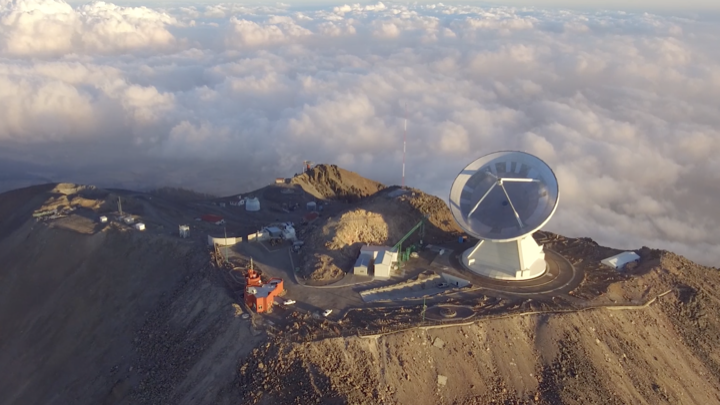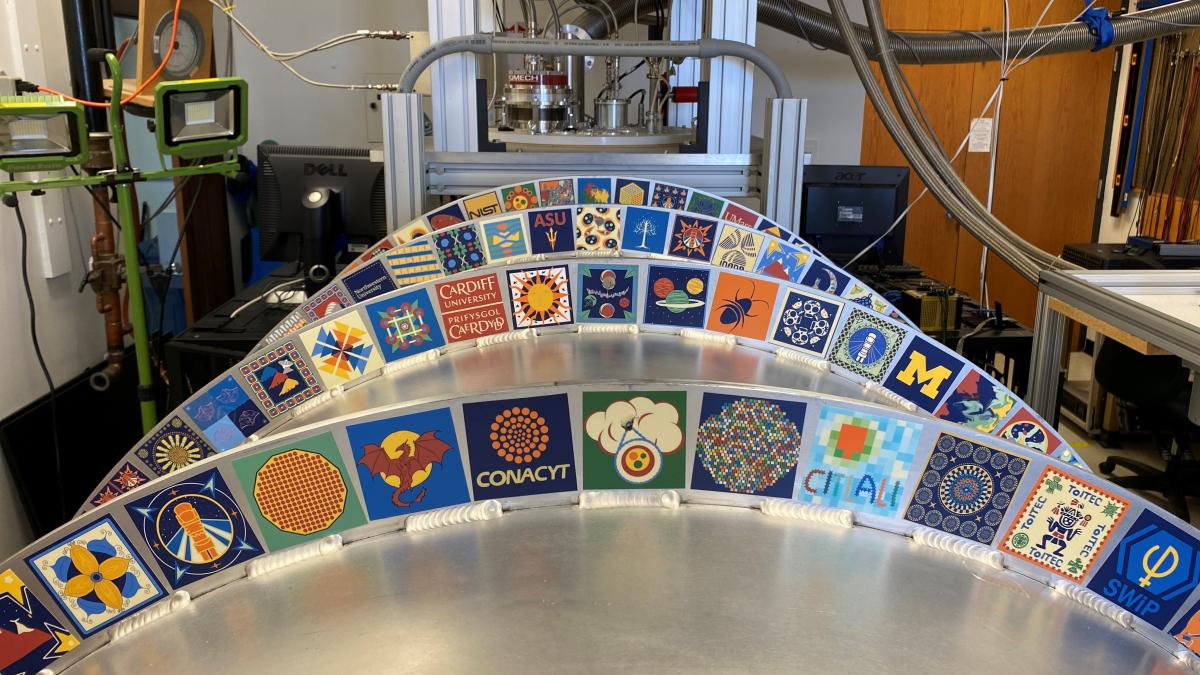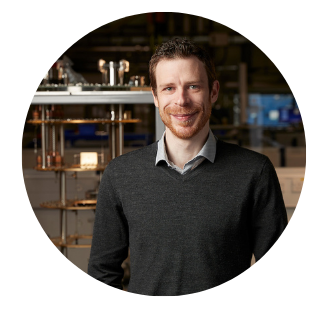Applications
 Part of the Oxford Instruments Group
Part of the Oxford Instruments Group
Expand
Collapse
Professor Grant Wilson from the Department of Astronomy, University of Massachusetts has been working on a Large Millimeter Telescope (LMT) project for a number of years.
In conversation with James Robinson at Oxford Instruments NanoScience, Professor Wilson shares crucial insight on the project, including the requirement for the TolTEC camera, the use of the Oxford Instruments Dilution Refrigerator, the history of the LMT and more. Click here to watch Professor Grant Wilson’s latest webinar.
The LMT is a joint project between the University of Massachusetts and the country of Mexico. It’s led by our Director, David Hughes at the National Institute of Astrophysics, Optics and Electronics, and by Project Manager, F. Peter Schloerb from University of Massachusetts.
The LMT is a 50 metre-diameter dish that aims to get the full surface root mean square (RMS) to 75 microns. So far we've been to 85, but we’re making good progress. It’s located on the peak of a dormant volcano called Sierra Negra, near Mexico City, and is what we believe to be the largest science project in Mexico's history. We run students down to the telescope regularly and have a very proud tradition of training the next generation of astronomers.
We’re moving on to our fifth year of early science with the telescope and since we began, we’ve shown that it’s a very valuable instrument. We’re even hoping to improve the telescope dramatically to increase the efficiency with which it can do science.

There are astrophysical processes in our universe over an incredibly vast array of scales. When people think about millimetre measurements, they tend to think of the cosmic microwave background. However, on a smaller scale than that, there are clusters of galaxies which are bright emitters at millimetre wavelength through the Sunyaev-Zel'dovich effect, and these affect emission on megaparsec scales.
But of course, clusters are composed of the galaxies which inhabit them. Again, they are very bright at millimetre wavelength, allowing us to study star formation on global scales and galaxies. We can zoom in on galaxies and measure star formation at much smaller scales, with now hundreds of parsecs in molecular clouds. We can even catch stars in the act of forming and look at them in the protoplanetary disks from which the planets arise in the stars, so there’s a lot to be seen.
We have fantastic facilities such as Atacama Large Millimeter Array (ALMA), which is an array of telescopes specialised to do sub-arcsecond millimetre wavelength imaging and spectroscopy. But if you want to understand the processes, that is at a very small scale, you need to also understand the environment in which these processes are happening. This isn’t something that ALMA was equipped to do.
The galaxies are very small, so in order to understand the environment that each galaxy is in, you must be willing to map a relatively sparse field that's filled with galaxies. You want to look at large-scale emission of dust to be able to trace where the gas is and where the star formation is occurring, and the answer to this challenge is with a large, single dish telescope. The single dish telescope allows you to put a big array of detectors behind a single dish, and the large aperture gives you the resolution that’s required.

We turned to a new detector technology called kinetic inductance detectors which is pretty simple. You build an inductor from a piece of superconductor, and if you put light on the superconductor, you can break Cooper pairs as long as the energy of the photons is bigger than the binding energy of the Cooper pairs. You can break those Cooper pairs and measure the breaking point as a change in the kinetic inductance of the inductor.
With the sensitive probe of the inductance, you put it in a resonant circuit with a capacitor so that you just have an LC resonance circuit. Then, you probe that resonance circuit with a signal down the transmission line, and if you were to sweep over a range of frequencies around the resonance frequency, your S21, which is the ratio of power coming out to what you've put in at each frequency, will experience a dip. As you change the optical loading on the inductor, you see the dip shift as the inductance of the inductor changes.
If you can do this once and you can do it cleanly, you can then set up multiple resonance circuits along the same transmission line. In our case, we try to keep the inductors identical across all of the different resonators that we build, and then we'll change the capacitor as we go.
We started off with a camera called AzTEC. It was developed in the early 2000s and seemed enormous at the time, but it had a total of 144 pixels and we put it to good use. We found galaxies, imaged protoplanetary disks, and proved that we were capable of making wide-scale maps in conjunction with Planck and other experiments of things like the Central Molecular Zone (CMZ). We retired the camera in 2017/18.
The AzTEC was a single frequency instrument with the one array. We realised that if we could double or triple the size of the array, we could do our science commensurately as fast, or maybe even faster. We looked at what detector technologies were available, and decided that we would be capable of scaling up the size of this camera by roughly 30-times larger in terms of the 1.1 Millimetre Array, and then we could even add additional arrays at other colours to take advantage of other atmospheric windows. Ultimately, we needed 60 times more detectors which required that we moved away from having a helium filled cryostat.
We decided to build a modular system, including the Oxford Instruments (OI) fridge, and the team at OI did a great job. The team spent time working out a way to implement high thermal conductivity links that were also mechanically compliant. This worked out really well.
Overall, I would say the system has been extremely robust and well behaved. With our system, we have copper bars riding along cylinders so that they can move in and out and be compliant along the longitudinal direction, but not move radially so that we don’t get thermal shorts. We have a still link at 1 Kelvin and a mixing chamber link at 0.1 Kelvin, and this is our dominant thermal impedance in the system. Having the flexibility of these braids and being able to make and break this link is essential to us, so we're happy with the temperatures we've gotten to. For anyone looking to do this, you will want to look at this link really hard as it's tough at millikelvin temperatures.
We plan to do 10 100-hour public legacy surveys with the LMT. We define the surveys through a series of public workshops where we bring in astronomers from around the world to find out what the best thing is that we could do with 100 hours of LMT time. Once the surveys are completed, we'll make all of that data public. To give you a sense of what 100 hours with the LMT equates to, if you add up the total cost of the LMT project over its 30 year lifetime, it’s roughly $35,000 to $40,000 a night. This is a big investment in time for our group, and we feel very dedicated and serious about making sure we get a lot of science out of it.
So far, we have finished the definition of the first four of these 100-hours surveys. They involve looking at star formation and molecular clouds through what we call the ‘clouds to coarse’ survey. We’re doing the ‘fields and filaments’ survey which is measuring magnetic fields as illuminated by the dust in the same way the Planck satellite did, but on much smaller scales. We also have two surveys on the extragalactic universe where we go very, very deep on small patches of sky to look at the galaxy populations and specifically the starburst galaxy populations.
We’re itching to get down to the telescope, but when we can get down to the telescope is really dependent on when things are safe enough in Mexico following COVID-19. We’re hoping to start the legacy surveys by the end of the year, so as soon as we can travel, we will!
Click here to watch Professor Grant Wilson’s latest webinar.

Professor Grant Wilson

James Robinson
Interviewer